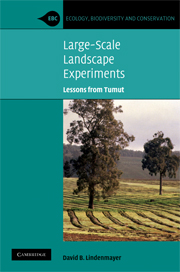Book contents
- Frontmatter
- Contents
- Preface
- Acknowledgements
- 1 The science of understanding landscape change: setting the scene for the Tumut Fragmentation Study
- 2 The theory: an overview of landscape change and habitat fragmentation
- 3 The field laboratory: the Tumut study area and the vertebrate animals it supports
- 4 Setting up the study: the design and implementation of the main cross-sectional study at Tumut
- 5 The core findings: the effects of landscape context on animals and plants
- 6 Patch use: how animals use patches of remnant eucalypt forest surrounded by pine
- 7 Theory against data: testing ecological theories and concepts
- 8 Testing PVA models with real data: melding demographic work with population modelling
- 9 Genes in the landscape: integrating genetic and demographic analyses
- 10 Refining and extending the research programme: additional studies at Tumut (and nearby) that build on the Fragmentation Study
- 11 Recommendations for plantation managers: implications for biodiversity and conservation in plantations
- 12 Lessons on running large-scale research studies: some insights from running the Tumut Fragmentation Study and directions for the future
- Appendix 1 List of collaborators/contributors to the Tumut Fragmentation Experiment
- Appendix 2 Detections of bird species in the Tumut Fragmentation Study classified by four broad classes of sites
- References
- Index
9 - Genes in the landscape: integrating genetic and demographic analyses
Published online by Cambridge University Press: 20 May 2010
- Frontmatter
- Contents
- Preface
- Acknowledgements
- 1 The science of understanding landscape change: setting the scene for the Tumut Fragmentation Study
- 2 The theory: an overview of landscape change and habitat fragmentation
- 3 The field laboratory: the Tumut study area and the vertebrate animals it supports
- 4 Setting up the study: the design and implementation of the main cross-sectional study at Tumut
- 5 The core findings: the effects of landscape context on animals and plants
- 6 Patch use: how animals use patches of remnant eucalypt forest surrounded by pine
- 7 Theory against data: testing ecological theories and concepts
- 8 Testing PVA models with real data: melding demographic work with population modelling
- 9 Genes in the landscape: integrating genetic and demographic analyses
- 10 Refining and extending the research programme: additional studies at Tumut (and nearby) that build on the Fragmentation Study
- 11 Recommendations for plantation managers: implications for biodiversity and conservation in plantations
- 12 Lessons on running large-scale research studies: some insights from running the Tumut Fragmentation Study and directions for the future
- Appendix 1 List of collaborators/contributors to the Tumut Fragmentation Experiment
- Appendix 2 Detections of bird species in the Tumut Fragmentation Study classified by four broad classes of sites
- References
- Index
Summary
The potential impacts of landscape change and habitat fragmentation on patterns of genetic variability have been widely discussed in the literature (Manel et al., 2003). However, relatively few large-scale empirical investigations have attempted to link genetic analyses with detailed field-based demographic studies until relatively recently (see Sarre et al., 1995; Saccheri et al., 1998; Keogh et al., 2007; reviewed by Manel et al., 2003). It is even rarer for integrated genetic and demographic analyses to be completed for multiple species in the same landscape (Schmuki et al., 2006a; Kraaijeveld-Smit et al., 2007).
The patch structure and field sampling framework at Tumut provided a useful platform on which to base detailed genetic studies that have been run concurrently with the demographic investigations described in the previous chapters. Genetic studies at Tumut targeted several species:
The native murid rodent, the Bush Rat (Lindenmayer and Peakall, 2000; Peakall et al., 2003, 2005; Peakall and Lindenmayer, 2006);
The native marsupial carnivore, the Agile Antechinus (Banks et al., 2005a, 2005b, 2005c);
The native arboreal marsupial, the Greater Glider (Lindenmayer et al., 1999f; Taylor et al., 2007);
Two species of native saproxylic beetles (Adelium calosomoides and Apasis puncticeps) (Schmuki et al., 2006a, 2006b).
This chapter summarises some of the findings of the landscape genetics work on these species. The first section is on the Bush Rat and is the longest because the work included a major removal and population recovery experiment (Lindenmayer et al., 2005a).
- Type
- Chapter
- Information
- Large-Scale Landscape ExperimentsLessons from Tumut, pp. 193 - 210Publisher: Cambridge University PressPrint publication year: 2009



